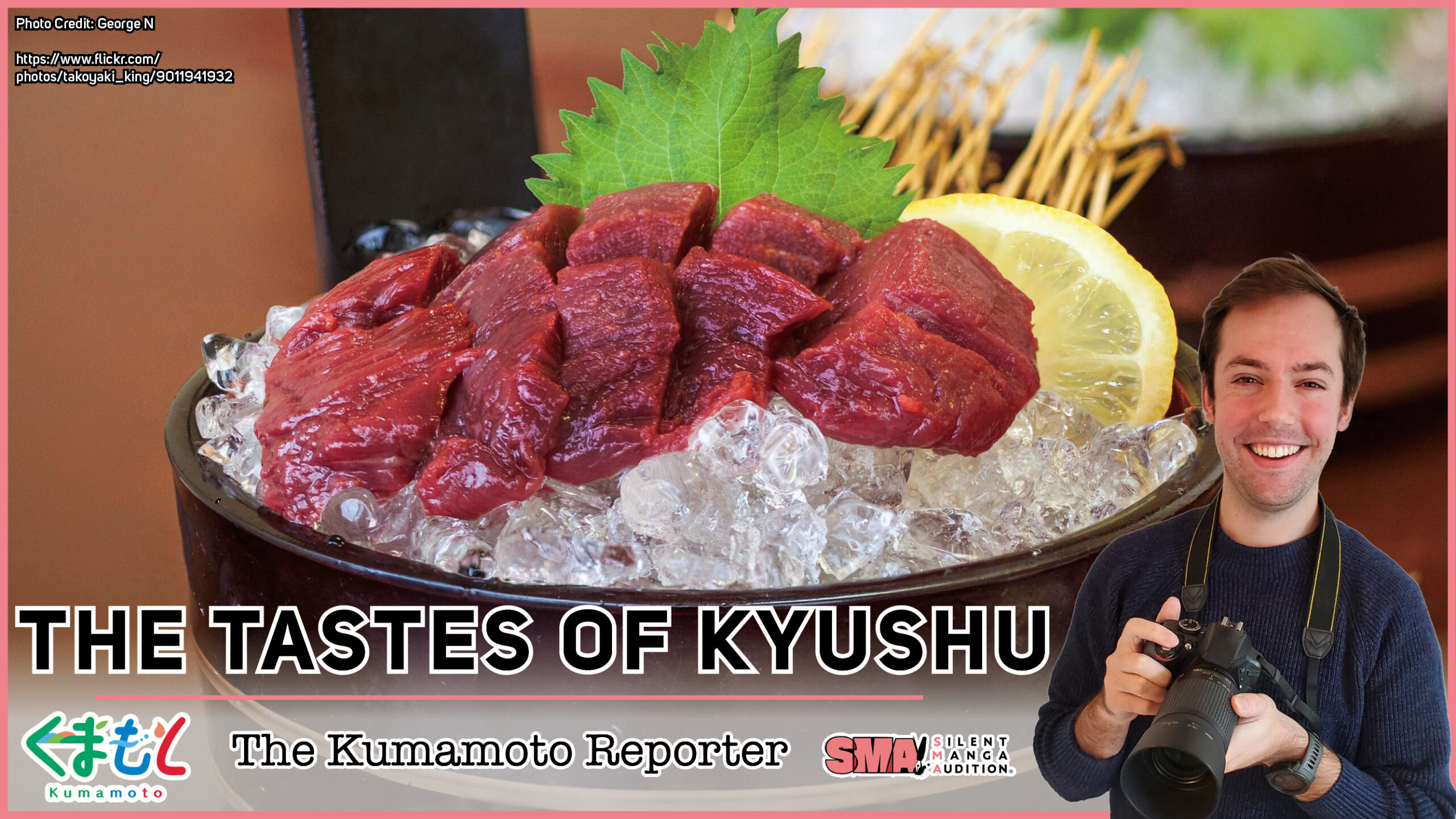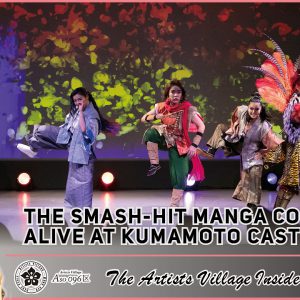
Hey SMA community! Last time we took a peek into the fantastical world of Kumamoto’s legends and infamous “Yokai,” or Japanese spirits. This time we’ll learn about another magical part of Kumamoto Prefecture and Kyushu: the food! Hope you guys are feeling hungry, we’re about to go on a food tasting trip across Kyushu to discover the most delectable specialties of each prefecture.
Kumamoto: Basashi
Basashi is a combination of the Japanese kanji for horse, which can be read as “Ba” and “sashimi” which is slices of raw fish served with soy sauce, wasabi, and ginger. Yup, that’s right; Basashi is slices of raw horse meat. There’s many speculations as to why it became a Kumamoto specialty, but one story tells of when samurai were forced to eat their horses when under siege in a castle. Served cold and with soy sauce like sashimi, Basashi is tender and sweet, similar to beef. If you’re hesitant to try Basashi, don’t worry; other famous Kumamoto tastes are Karashi Renkon (mustard lotus root), Japanese brown beef from Aso, Kumamoto ramen, and a Chinese-based noodle dish called Taipien.
Fukuoka: Hakata Ramen
When people think of Kyushu ramen, they think of Hakata ramen! Served with a creamy pork bone based broth, Hakata ramen’s signature style is its thin noodles. It usually comes with thin slices of pork and chopped green onions, but if you’re feeling in the mood for some variety you can also add a hard boiled egg, wood ear mushrooms, pickled ginger root, garlic, bean sprouts, sesame seeds, or more. The Hakata and Tenjin districts of Fukuoka City are also known for their late night food stalls called “Yatai,” and a hot pot dish made with pork tripe is also a famous Fukuoka speciality.
Nagasaki: Champon
MORE noodles! Champon is made by frying pork, seafood, and vegetables together, and then boiling it all together in soup with a special type of ramen noodle. It’s inspired by Chinese food, which is only natural since Nagasaki has its own Chinatown and deep history with Chinese trade. If you do make your way to the oldest Chinatown in Japan, you can enjoy Chinese food with a Nagasaki twist and Nagasaki’s famous Turkish Rice dish. If you’re fiending for dessert afterward, be sure to try Nagasaki’s famous Castella cake!
Saga: Aritaware Curry
Aritaware Curry’s name has a double meaning; the curry is a special kind of Japanese curry that’s baked, which is then served in “Arita yakimono.” Arita yakimono is the Japanese name for Arita City’s pottery, which literally means “baked” or “burnt” thing in Japanese. Saga’s pottery is famous all over Japan, and often has pottery festivals where you can buy beautiful handcrafted pieces. But enough about pottery, back to the food! Some other famous tastes in Saga include Karatsu Burger, Kanzaki Soumen, boiled tofu, squid, and other seafood.
Oita: Dango Jiru
Soup for the soul! Dango Jiru is Oita’s unique spin on “Dago Jiru,” a healthy soup that is popular across Kyushu. Dango are round Japanese dumplings, but in Oita they are stretched out into the shape of noodles and cooked with chicken and vegetables in miso soup. “Jigoku Mushi” is another unique cuisine of Oita, and comes from Beppu’s “hells” or hot springs. Ingredients such as vegetables and eggs are placed in a small chamber and with a lid placed over them, and with time the steam from the hot springs cook the ingredients! Other famous tastes of Oita include tempura style fried chicken, Reimen (cold noodles), and Hyugadon, which is tuna over rice.
Miyazaki: Chicken Nanban
Chicken Nanban is an example of Western food that has been adapted to suit Japanese tastes. Originating in Miyazaki, juicy fried chicken called “Karaage” is marinated with a special sauce and then covered in tartar sauce. This indulgent spin on fried chicken may not be the healthiest, but Chicken Nanban is often served with salad on the side. Other tastes of Miyazaki include Karamen (spicy noodles), rice balls wrapped in pork, Miyazaki beef, and mango flavored sweets.
 Kagoshima: Kurobuta
Kurobuta, which literally means “black pig,” are said to have been brought to Kagoshima from the Ryukyu Kingdom (which includes present day Okinawa) about 400 years ago. Today, free-range Kurobuta in Kagoshima are known for their sweetness and rich flavor. The meat is crisp, tender, firm, and juicy, with the fat being light. You can savor this high-quality meat in a variety of ways, but eating it in a kind of hot-pot dish called Shabu-Shabu is hugely popular. Shabu-Shabu is traditionally enjoyed with beef, but Kurobuta has made pork Shabu-Shabu spread across Japan. Other famous tastes of Kagoshima include Abura Soumen, shaved-ice called “Shiro-Kuma,” chicken sashimi, and sweet potato shochu, an alcoholic drink much stronger than sake.
These are the most famous mouth watering specialties of each prefecture in Kyushu, but Kyushu is also known for its high quality fruit, vegetables, livestock, and marine products. If you want to learn more about how this connects to us in the Artists Village, be sure to check out the latest article from the Artists Village Insider to learn more about Zizoya, the gourmet subsidiary of COAMIX Inc., and how they’re merging manga with gourmet!
Kagoshima: Kurobuta
Kurobuta, which literally means “black pig,” are said to have been brought to Kagoshima from the Ryukyu Kingdom (which includes present day Okinawa) about 400 years ago. Today, free-range Kurobuta in Kagoshima are known for their sweetness and rich flavor. The meat is crisp, tender, firm, and juicy, with the fat being light. You can savor this high-quality meat in a variety of ways, but eating it in a kind of hot-pot dish called Shabu-Shabu is hugely popular. Shabu-Shabu is traditionally enjoyed with beef, but Kurobuta has made pork Shabu-Shabu spread across Japan. Other famous tastes of Kagoshima include Abura Soumen, shaved-ice called “Shiro-Kuma,” chicken sashimi, and sweet potato shochu, an alcoholic drink much stronger than sake.
These are the most famous mouth watering specialties of each prefecture in Kyushu, but Kyushu is also known for its high quality fruit, vegetables, livestock, and marine products. If you want to learn more about how this connects to us in the Artists Village, be sure to check out the latest article from the Artists Village Insider to learn more about Zizoya, the gourmet subsidiary of COAMIX Inc., and how they’re merging manga with gourmet!

 Kagoshima: Kurobuta
Kurobuta, which literally means “black pig,” are said to have been brought to Kagoshima from the Ryukyu Kingdom (which includes present day Okinawa) about 400 years ago. Today, free-range Kurobuta in Kagoshima are known for their sweetness and rich flavor. The meat is crisp, tender, firm, and juicy, with the fat being light. You can savor this high-quality meat in a variety of ways, but eating it in a kind of hot-pot dish called Shabu-Shabu is hugely popular. Shabu-Shabu is traditionally enjoyed with beef, but Kurobuta has made pork Shabu-Shabu spread across Japan. Other famous tastes of Kagoshima include Abura Soumen, shaved-ice called “Shiro-Kuma,” chicken sashimi, and sweet potato shochu, an alcoholic drink much stronger than sake.
Kagoshima: Kurobuta
Kurobuta, which literally means “black pig,” are said to have been brought to Kagoshima from the Ryukyu Kingdom (which includes present day Okinawa) about 400 years ago. Today, free-range Kurobuta in Kagoshima are known for their sweetness and rich flavor. The meat is crisp, tender, firm, and juicy, with the fat being light. You can savor this high-quality meat in a variety of ways, but eating it in a kind of hot-pot dish called Shabu-Shabu is hugely popular. Shabu-Shabu is traditionally enjoyed with beef, but Kurobuta has made pork Shabu-Shabu spread across Japan. Other famous tastes of Kagoshima include Abura Soumen, shaved-ice called “Shiro-Kuma,” chicken sashimi, and sweet potato shochu, an alcoholic drink much stronger than sake.

































